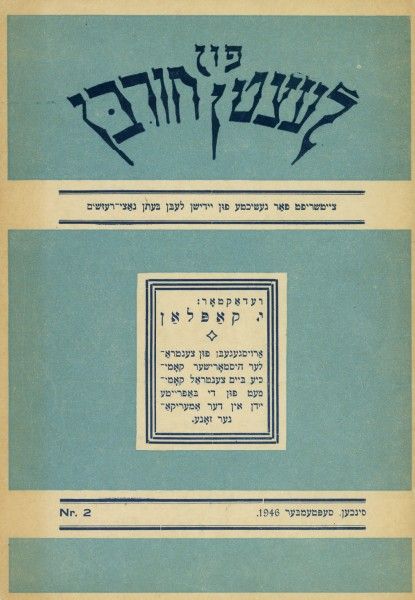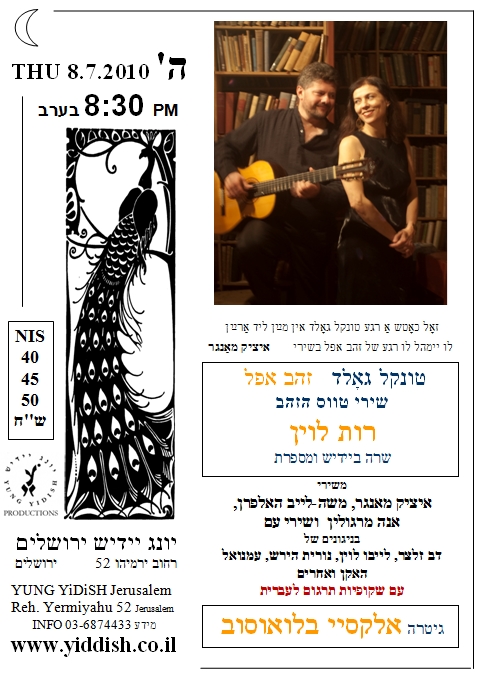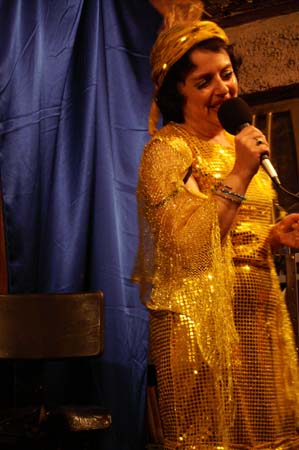בשעה 4 נתכנס כדי לזכור ולהפנים את החורבן והתקומה ונתאחד עם זכרונות, עדויות ושירים המהדהדים בין דפי היידיש אשר בספרייה.
יונג יידיש תהיה פתוחה למבקרים ולמתנדבים בסידור הספרים מ-11 בבוקר ועד 8 בערב.
נשתדל גם לשדר בLIVE פרטים אח"כ (שפעטער א ביסעלע….)
יונג יידיש תהיה פתוחה למבקרים ולמתנדבים בסידור הספרים מ-11 בבוקר ועד 8 בערב.
נשתדל גם לשדר בLIVE פרטים אח"כ (שפעטער א ביסעלע….)
מיר וועלן זיך צוזאמען קומען 4 נ"מ כדי זיך צו דערמאנען און זיך צו טרייסטן און שטארקן מיט די זכרונות און לידער, פארבליבענע ברעקלעך און עדותן פונעם לעצטן חורבן
יונג יידיש איז אפן היינט פון 11 אינדערפרי. קומט אריין פאר א באזוך, א נחמה אדער מסדר זיין די ביכער.
יונג יידיש איז אפן היינט פון 11 אינדערפרי. קומט אריין פאר א באזוך, א נחמה אדער מסדר זיין די ביכער.
Join us at 4pm at our YUNG YiDiSH Holocaust commemoration, with Yiddish texts, songs and memories, and light a candle.
Volunteers and visitors welcome from 11am to 8pm
Volunteers and visitors welcome from 11am to 8pm
some information about the illustration:
Fun letstn khurbn / From the Last Annihilation
(cited from https://www.holocaustliteratur.de/…/Edition-of-the…/)
Fun letstn khurbn / From the Last Annihilation
(cited from https://www.holocaustliteratur.de/…/Edition-of-the…/)
Throughout Europe, Jewish survivors had organized themselves into historical committees and documented the persecution and murder of the Jews by the National Socialists. They collected documents, but above all, they questioned other survivors and motivated them to write. They included activities such as the circle around Emanuel Ringelblum in the Warsaw Ghetto, as well as similar initiatives in the ghettos of Vilnius and Bialystok and others. These efforts of documentation have become more and more the focus of the public and of research in recent years. However, much of the early documentation was written in Yiddish and therefore remains largely inaccessible to the interested public.
The central institution for collecting and documenting in occupied Germany was the Central Historical Commission of the Central Committee of the Liberated Jews in Munich. Here many activities from individual regions and camps for so-called displaced persons came together. Israel Kaplan and Moyshe Feygenboym published the journal “Fun Letstn Khurbn. Tsaytshrift far geshihkte fun Yidishn leben beysn natsi-rezhim” (“From the Last Annihilation. Journal for the History of Jewish Life under the Nazi-Regime”) until December 1948 to support the collection activities and to publish their first results. A total of 10 editions appeared with 36 to 186 pages and circulated 5,000 to 8,000 copies.
Kaplan and Feygenboym were primarily concerned, as was the Commission as a whole, with an “everyday”, cultural history of the Holocaust, in which the persecuted do not appear as numbers in statistics, the communities not as places in listings, but as people with faces and stories as well as living communities and social services. Therefore, they placed special emphasis on such documents and reports that dealt with the Holocaust in jokes, rumors, legends and anecdotes. Moreover, they documented everyday life, annihilation and resistance, especially in the smaller ghettos and less well-known camps in German-occupied Eastern Europe, away from remembrance sites that dominated immediately after the war, such as the Warsaw Ghetto. Thus, they created an innovative project that was far ahead of its time and dealt with topics and applied methods that were 'discovered' by (university) research only decades later.
The journal became not only a central publication vehicle for Holocaust literature in the early post-war period, but also inspired many survivors to share their experiences. While the Central Historical Commission was able to collect a total of 300 reports in the first ten months of its existence, even before the magazine's publication, its number grew to a proud 700 in the seven months following the publication of the first edition.

![[YYjer] Klezmer Farbrengenish קלעזמער מלווה מלכה](https://yiddish.co.il/wp-content/themes/customizr/assets/front/img/thumb-standard-empty.png)

